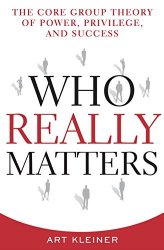 Summary: Our earliest experiences with Core Groups stay with us and become generalized. That is, without effort, we perceive and interact with all future Core Groups as if they were like the first ones we encountered. This hinders us from seeing the Core Groups of our present as they are and working with them effectively. One strategy for breaking this pattern is to consciously develop an Inner Core Group based on what we actually value.
Summary: Our earliest experiences with Core Groups stay with us and become generalized. That is, without effort, we perceive and interact with all future Core Groups as if they were like the first ones we encountered. This hinders us from seeing the Core Groups of our present as they are and working with them effectively. One strategy for breaking this pattern is to consciously develop an Inner Core Group based on what we actually value.
Who Really Matters (Amazon, Goodreads, Powells) puts forth the theory that central to every organization is a Core Group of people who really matter.
This post is part of a series summarizing the book and covers Chapter 14: Your Inner Core Group. You may want to start with the introduction.
Chapter 14: Your Inner Core Group
This chapter explores how our first experiences with a Core Group stick with us to influence our future interactions with Core Groups and ways to break this habit.
Kleiner starts this chapter by sharing several early Core Group stories, including one of his own. In these stories, he notices a common theme:
We had internalize the Core Group of our early careers and carried them with us, like “inner Core Groups” that shaped our expectations for the rest of our lives. (p. 126)
That is, we generalize our early Core Group experiences and apply them to all future Core Group interactions:
People mistakenly assume that a pattern set long ago, by some other Core Group in some other organization, will be universal. We carry with us the Core Group members who have supported us or rejected us in the past, in a kind of Inner Core Group–and we try (usually unsuccessfully) to recreate the nature of that Inner Core Group in the organizations of the moment. (p. 129)
The downside of this is that it gives us inaccurate information about how to proceed in the present. Core Groups are not universal in their composition, their behavior, or their attitudes towards us.
It can be quite difficult to break this Inner Core Group cycle:
The Inner Core Group is invisible when you are consciously at your best. It manifests itself in high-stress moments–arguments with the boss, sudden deadlines, decisions to quit–when you don’t have much perspective and it’s particularly hard to change old habits. And in low-stress moments, when there’s a lot of time to reflect, it doesn’t seem quite so important or difficult to deal with. (p. 129)
One strategy for breaking the cycle is to reflect upon and rehearse new ways of interacting with the Core Group patterns that have frustrated you in the past. Over time, you can build an alternative Inner Core Group, one that is “consciously created mental image of the people who are truly important to you, on whose behalf you will be making decisions.”
Kleiner closes the chapter by speaking to the value of dialogue work, which he describes as “a practice of collective thought and in-depth conversation.” For more on dialogue work, see Dialogue: The Art of Thinking Together (Amazon), by William Isaacs.
Quoting Isaacs, Kleiner underscores the importance of overcoming the Inner Core Group formed by early experience and intentionally developing an Inner Core Group true to you:
You think you’re in a Core Group or you’re not, because of some external factor. You go to school, for instance, because you think the degree will get you into the Core Group. You wonder, ‘How come this person got in and that person did not? How do I get to be part of it?’ And all along you’re bypassing the critical question: ‘Are you at the Core of your own life? Are you making decisions on behalf of your deepest unfolding potential.‘ (p. 131)
What’s Next?
Stay tuned for our next post in this series, a summary of Chapter 15: Core Group Enablers.
Citations
Kleiner, Art. Who Really Matters: The Core Group Theory of Power, Privilege, and Success. 1st ed. New York: Currency/Doubleday, 2003.
This post is part of our Book Summary series in which we share summaries of books about leadership, governance, and community building. To discuss the book, leave a comment below or join our Goodreads group.


0 Comments